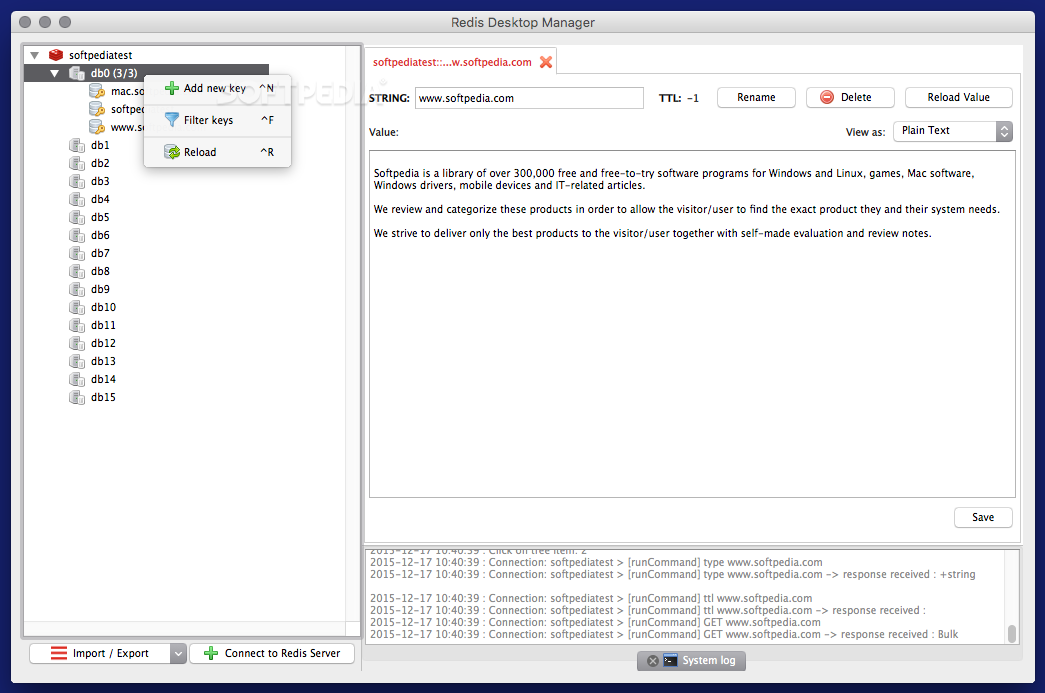Redis Desktop Manager. Contribute to kanyways/rdm development by creating an account on GitHub. Open with GitHub Desktop Download ZIP Launching GitHub Desktop. Aug 08, 2020 Quickly connect to Redis servers and save configuration files. Within the Redis Desktop Manager main window you must start by connecting to a Redis server: define a connection name, provide the host address, the available port, and provide the authentication password if necessary. Download Redis Desktop Manager for mac os x, windows, debian and ubuntu.
Redis is a high performance data store solution, it is a one more step forward in the “No SQL” regime and developers are using this store to achieve reliable performance and flexibility for their applications. Redis can be used as database, cache and message broker. It supports wide range of data structures and atomic operations. It uses an “in-memory dataset” for achieving optimized performance.
Redis works on Linux and Mac operating systems; for production environments, it is recommended to use Redis on Linux OS. Redis supports a large number of programming languages and currently efforts are being made to make this available for Windows operating system too. In this article, we will learn how to install Redis on Ubuntu Linux and how to manage Redis using Redis Desktop Manager tool.
Installing Redis Desktop Manager
As already mentioned, Redis Desktop Manager gives users a great ease to manage their Redis intance. In order to install Redis Desktop Manager, launch your system terminal and download its installer package for ubuntu using following command.
Once the download process is complete, install Redis Desktop Manager by using following command.
Congratulations! Redis Desktop Manager has been installed now, launch it by simply typing.
Redis For Mac
In order to connect your localhost or remote Redis server, click “Connect to Redis Server” tab and it will load a login window, here specify your Redis server details.
There you go, you are connected to your Redis instance now, start using it for your required operations.
Conclusion
Redis is being used by many experts for their production and critical applications. The popularity for this tool is on the rise and we should see more and more features in the coming era. No-SQL techniques have gained massive popularity due to their speed, easy of use and flexibility.
Redis uses a standard practice for its versioning: major.minor.patchlevel. An even minor marks a stable release, like 1.2, 2.0, 2.2, 2.4, 2.6, 2.8. Odd minors are used for unstable releases, for example 2.9.x releases are the unstable versions of what will be Redis 3.0 once stable.
Unstable
This is where all the development happens. Only for hard-core hackers. Use only if you need to test the latest features or performance improvements. This is going to be the next Redis release in a few months.Stable (6.0)
Redis 6.0 introduces SSL, the new RESP3 protocol, ACLs, client side caching, diskless replicas, I/O threads, faster RDB loading, new modules APIs and many more improvements.Docker
It is possible to get Docker images of Redis from the Docker Hub. Multiple versions are available, usually updated in a short time after a new release is available.
You can also use the free Redis Cloud service from Redis Labs.
*Other versions
Old (5.0)
Redis 5.0 is the first version of Redis to introduce the new stream data type with consumer groups, sorted sets blocking pop operations, LFU/LRU info in RDB, Cluster manager inside redis-cli, active defragmentation V2, HyperLogLogs improvements and many other improvements. Redis 5 was release as GA in October 2018.See the release notes or download 5.0.10.
*Other
Historical downloads are still available on Google Code.Scripts and other automatic downloads can easily access the tarball of the latest Redis stable version at https://download.redis.io/redis-stable.tar.gz, and its respective SHA256 sum at https://download.redis.io/redis-stable.tar.gz.SHA256SUM. The source code of the latest stable release is always browsable here, use the file src/version.h in order to extract the version in an automatic way.
*How to verify files for integrity
The Github repository redis-hashes contains a README file with SHA1 digests of released tarball archives. Note: the generic redis-stable.tar.gz tarball does not match any hash because it is modified to untar to the redis-stable directory.
*Installation
Redis Desktop Manager Mac Download Torrent

*From source code
Download, extract and compile Redis with:
The binaries that are now compiled are available in the src directory. Run Redis with:
You can interact with Redis using the built-in client:
*From the official Ubuntu PPA
You can install the latest stable version of Redis from the redislabs/redis package repository. Add the repository to the apt index, update it and install:
*From Snapcraft
You can install the latest stable version of Redis from the Snapcraft marketplace:
Redis Gui
Are you new to Redis? Try our online, interactive tutorial.
